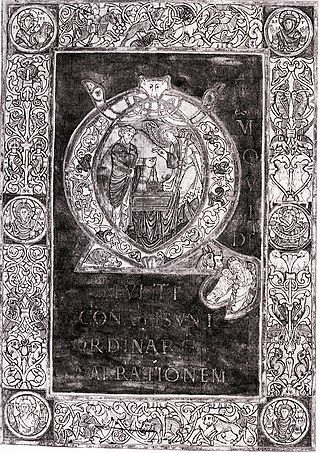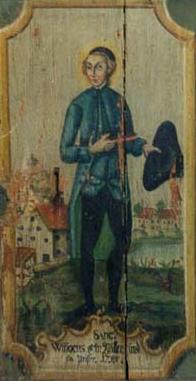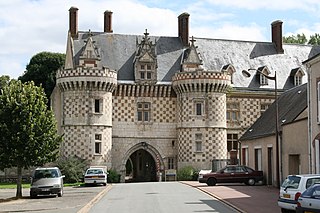
The Tironensian Order or the Order of Tiron was a medieval monastic order named after the location of the mother abbey in the woods of Thiron-Gardais in Perche, some 35 miles west of Chartres in France). They were popularly called "Grey Monks" because of their grey robes, which their spiritual cousins, the monks of Savigny, also wore.

Bertin, also known as SaintBertin the Great, was the Frankish abbot of a monastery in Saint-Omer later named the Abbey of Saint Bertin after him. He is venerated as a saint by the Catholic and Orthodox Churches. The fame of Bertin's learning and sanctity was so great that in a short time more than 150 monks lived under his rule. Among them were St. Winnoc and his three companions who had come from Brittany to join Bertin's community and assist in the conversions. Nearly the whole Morini region was Christianized.

Bergues is a commune in the Nord department in northern France.

The Abbey of Saint-Étienne, also known as Abbaye aux Hommes by contrast with the Abbaye aux Dames, is a former Benedictine monastery in the French city of Caen, Normandy, dedicated to Saint Stephen. It was founded in 1063 by William the Conqueror and is one of the most important Romanesque buildings in Normandy.

Affligem Abbey is a Benedictine abbey in the municipality of Affligem, Flemish Brabant, Belgium, 19 km (12 mi) to the north-west of Brussels. Dedicated in 1086, it was the most important monastery in the Duchy of Brabant and therefore often called Primaria Brabantiae.

Fleury Abbey (Floriacum) in Saint-Benoît-sur-Loire, Loiret, France, founded in about 640, is one of the most celebrated Benedictine monasteries of Western Europe, and possesses the relics of St. Benedict of Nursia. Its site on the banks of the Loire has always made it easily accessible from Orléans, a center of culture unbroken since Roman times. In 2010, the abbey had over forty monks led by the abbot Etienne Ricaud.

The Abbey of St Vaast was a Benedictine monastery situated in Arras, département of Pas-de-Calais, France.

Winnoc was an abbot or prior of Wormhout who came from Wales. Three lives of the saint are extant. The best of them is the first life, which was written by a monk of Bertin in the mid-9th century or perhaps a century earlier.
Lobbes Abbey was a Benedictine monastery in the municipality of Lobbes, Hainaut, Belgium. The abbey played an important role in the religious, political and religious life of the Prince-Bishopric of Liège, especially around the year 1000. The abbey's founding saint is Saint Landelin; four other saints are also connected with the abbey.

Saint Godelieve is a Flemish saint. She behaved with charity & gentleness to all, accepting an arranged marriage as was the custom, but her husband and family turned out to be abusive. Eventually he had her strangled by his servants.

Glanfeuil Abbey, otherwise the Abbey of St Maurus, was a French Benedictine monastery founded in the 9th century in the village of Saint-Maur-sur-Loire, located in what is now the commune of Le Thoureil, Maine-et-Loire.
Adelolf, Count of Boulogne, was a younger brother of Arnulf I, Count of Flanders and was granted the County of Boulogne by his father.

The Abbey of Saint Bertin was a Benedictine monastic abbey in Saint-Omer, France. The buildings are now in ruins, which are open to the public. It was initially dedicated to Saint Peter but was rededicated to its second abbot, Saint Bertin. The abbey is known for its Latin cartulary whose first part is attributed to Folcwin.

Bonneval Abbey, also known as St. Florentinus' Abbey, is a former Benedictine monastery in Bonneval, Eure-et-Loir, in France.

Marchiennes Abbey was a French monastery located on the Scarpe in Marchiennes. It was founded around 630 by Adalbard of Douai, and Irish monks, disciples of Saint Columbanus, on the advice of Saint Amand. One of its founders was Rictrude, who made it double monastery in 643. In around 1024 it became monastery of men again and adopted the Benedictine rule. On the birth of the town of Marchiennes the abbey became its economic motor until being suppressed in 1791 during the French Revolution. In 1814 all but its 1748 gatehouse was demolished. Its remains were inscribed on the inventory of monuments historiques on 17 May 1974,

Redon Abbey, or Abbey of Saint-Sauveur, Redon, in Redon in the present Ille-et-Vilaine, Brittany, France, is a former Benedictine abbey founded in 832 by Saint Conwoïon, at the point where the Oust flows into the Vilaine, on the border between Neustria and Brittany.

Saint-Mihiel Abbey is an ancient Benedictine abbey situated in the town of Saint-Mihiel, near Verdun in the Meuse department in Lorraine in north-eastern France.

Ename Abbey (1063–1795) was a Benedictine monastery in the village of Ename, now a suburb of Oudenaarde. It was founded by Adele of France, wife of Baldwin V, Count of Flanders, and was confiscated during the French Revolutionary Wars. It was then sold and dismantled.

Ten Putte Abbey is a monastery with an abbey in Gistel, roughly 8 km to the south of Ostend, in the western part of Belgium. It was built to mark the spot where, in 1070, Saint Godelina was murdered by strangulation and then thrown into a pond. Before 2007 the abbey was home to nine Benedictine nuns, who were members of the wider Subiaco Cassinese Congregation in West Flanders. Since 2007 it has been occupied by brothers and sisters of the "Mother of Peace" community.
Saint Folcwin or Folcuin was a Frankish abbot, cleric, and Bishop of Thérouanne.


















